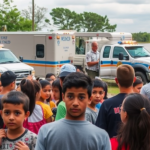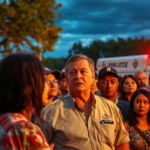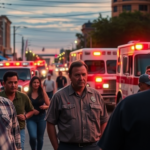ICE Deports Mexican National Wanted in Disappearance of 43 Students
In a significant development highlighting the complex dynamics along the U.S.-Mexico border, U.S. Immigration and Customs Enforcement (ICE) recently deported Ariel Nuñez Figueroa, a Mexican national allegedly connected to the 2014 abduction and disappearance of 43 students in Mexico. Captured by ICE operatives in Houston, Nuñez was handed over to Mexican authorities at the Juarez-Lincoln Bridge Port of Entry in Texas. This deportation underscores heightened efforts by ICE to address unresolved cases and collaborate with international agencies to secure justice.
Backdrop to a Notorious Crime
The disappearance of 43 male students from the Ayotzinapa Teachers’ College in Guerrero, Mexico, in September 2014 remains one of the most notorious unsolved cases in recent Mexican history. Initially, the students, involved in commandeering buses for a protest, were misidentified as members of a rival drug gang by local authorities connected to the Guerreros Unidos cartel. Subsequent investigations exposed the involvement of security forces and multiple layers of official cover-ups, implicating local, state, and federal authorities in thwarting the truth.
ICE Houston Field Office Director, Bret Bradford, emphasized the agency’s commitment to international cooperation, stating, “For nearly eleven years, this foreign fugitive evaded authorities while the family and friends of those 43 students patiently awaited justice. Thanks to outstanding teamwork by ICE, Interpol, and the U.S. Embassy in Mexico, we were able to successfully track him down and remove him to Mexico to face prosecution for his alleged crimes.”
Local Impact and Perspectives in the Rio Grande Valley
This high-profile deportation resonates deeply within the Rio Grande Valley (RGV), an area closely tied to cross-border dynamics. The RGV community is uniquely positioned at the forefront of international immigration issues, seeing firsthand the interplay of law enforcement, human rights, and local socio-economic factors.
Local experts and advocates highlight the juxtaposition of intensified border enforcement with ongoing humanitarian concerns. Maria Torres, a McAllen-based immigration attorney, commented, “While it’s vital to hold accountable those implicated in grave crimes, we must remain vigilant about the broader implications for migrant communities. The RGV, rich with cultural ties to Mexico, often grapples with balancing security and compassion.”
Ongoing Challenges: Family Detention Centers and Drug Trafficking
Amidst these enforcement actions, concerns persist about the potential reopening of family detention centers in Texas. Advocacy groups argue such facilities could have detrimental effects on migrant families, echoing broader debates about immigration policies impacting Valley residents.
In parallel, border crime challenges remain prevalent, as evidenced by the recent discovery of $6.2 million worth of cocaine wrapped in plastic at the border. This incident underscores the persistent threat of drug trafficking, requiring ongoing vigilance by border security.
Linking Past and Present
For Valley residents, Ariel Nuñez Figueroa’s deportation serves as a reminder of the intricate connections between regional issues and broader geopolitical narratives. The case draws a direct line to past events affecting the border, reinforcing the need for strategic, informed engagements with cross-border crime.
Community leader and educator Juan Hernandez notes, “The RGV has always been a reflection of broader issues at the U.S.-Mexico border. Addressing complex cases like Ayotzinapa involves not only justice but also understanding and preventing future tragedies. It’s about learning and improving from the past.”
Potential Future Implications
Moving forward, the repercussions of ICE’s actions could extend beyond Ariel Nuñez Figueroa’s case. The coordination between U.S. and Mexican authorities augurs well for tackling other unresolved cases, potentially fostering a broader atmosphere of trust and collaboration across the border.
However, these developments also cast a spotlight on the critical balance of maintaining regional security while safeguarding human rights. As such, it’s essential for policymakers and local stakeholders to engage in open, continuous dialogue to navigate these multifaceted challenges.
For RGV residents seeking more information about local immigration policies and their implications, community resources are available through Valley-based non-profits and advocacy organizations. These entities provide crucial support and advocacy, ensuring that community voices remain central to discussions about immigration and border security.
In sum, the deportation of Ariel Nuñez Figueroa is emblematic of ongoing efforts to pursue justice in complex international criminal cases, amidst the broader tapestry of border-related issues in South Texas and beyond. As the Rio Grande Valley community continues to grapple with these realities, such stories serve not only as newsworthy events but also as pivotal moments for reflection and progress.







